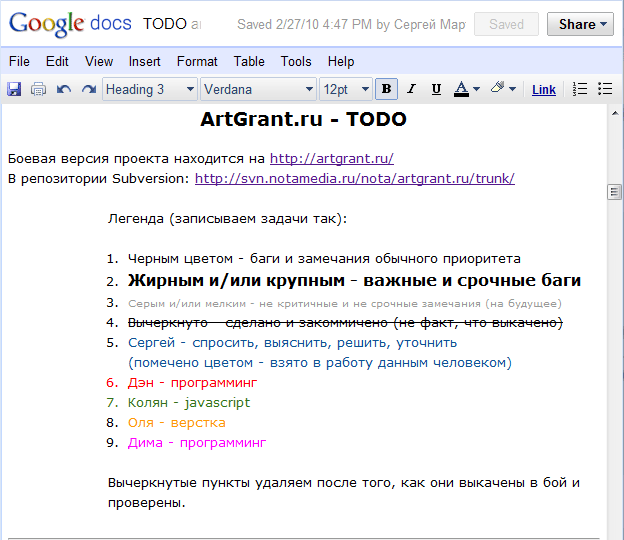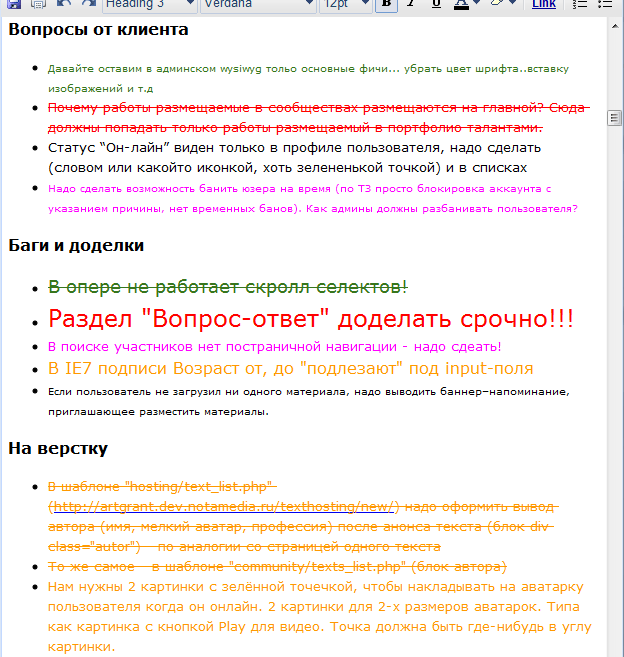“Color pencils” - an ideal task accounting system
Like any serious team, we have a real task accounting system: with projects and working groups, with separation of user roles and access rights, taking into account the time and life cycle of the task. But life, as usual, is a multifaceted thing, and it is not always convenient to fit into the cold logic of the task tracker. This is especially noticeable on long-term projects, when you need to make a team breakthrough and accomplish the impossible in a few days ;) And in such situations , we came up with this unexpected approach, which I want to share.
We keep track of tasks not in a solid task tracker, but in a ... text file. More precisely, not just text, but in a shared Google Docs document. It happens like this:
We usually put a "legend" at the beginning of the file so that you can always remember where whose color is. Here's what it looks like:

We have been using this approach for several months now. Among its advantages (which we have managed to feel on ourselves more than once):
Here's a lively (well, almost lively ) example of a list of tasks from one of our projects , which was made just in a very short time:

Of course, our solution is not a panacea. Ideal solutions do not exist at all ( forgive me for the loud topic heading ), and this also has its own problems and limitations. At least such:
But despite the flaws, our planner works well. In what situations it is worth using this approach - I think everyone will decide for himself. Just try it - at least it's fun ;)
We keep track of tasks not in a solid task tracker, but in a ... text file. More precisely, not just text, but in a shared Google Docs document. It happens like this:
- We write down the arising tasks in plain black font as a regular unordered list.
- The font size marks the priority of tasks - the larger, the more important.
- We mark with the color the tasks assigned to a specific person - each developer has his own color.
We usually put a "legend" at the beginning of the file so that you can always remember where whose color is. Here's what it looks like:

We have been using this approach for several months now. Among its advantages (which we have managed to feel on ourselves more than once):
- Speed of use - no need to fill out large forms and click on buttons - just type or copy a couple of phrases into an already open document.
- Dynamism - changes in Google Docs are saved quickly and are displayed in real-time on the screens of colleagues.
- Flexibility of description - as a task you can insert just a couple of words marked "kick me - I will tell you", or you can copy a piece of TK, letter, or text on the site.
- Convenience of visualization - all tasks of the project are in front of each member of the team, there is always a general picture that shows the priorities marked with the font size. Crossing out tasks clearly shows the progress of work, color marking of the performer helps you to grasp your tasks while looking at their place in the big picture.
- Hierarchy of tasks - interdependent tasks can be written in the form of nested lists, irrelevant or deferred - transfer to the end of the document, divide the document into parts, insert textual explanations.
- Change History - Google Docs allows you to see who, when and what rules are in the file, and if you need to pull dead tasks from previous versions.
Here's a lively (well, almost lively ) example of a list of tasks from one of our projects , which was made just in a very short time:

Of course, our solution is not a panacea. Ideal solutions do not exist at all ( forgive me for the loud topic heading ), and this also has its own problems and limitations. At least such:
- There are no options for sorting or filtering tasks; you have to regroup manually
- It is inconvenient to insert large chunks of text as a description of tasks (the document is spreading), the presence of collapsing blocks would help here
- There are drawbacks of the google docs engine itself - for example, sometimes there are glitches with formatting (especially when there were a lot of inserts from different sources)
But despite the flaws, our planner works well. In what situations it is worth using this approach - I think everyone will decide for himself. Just try it - at least it's fun ;)
